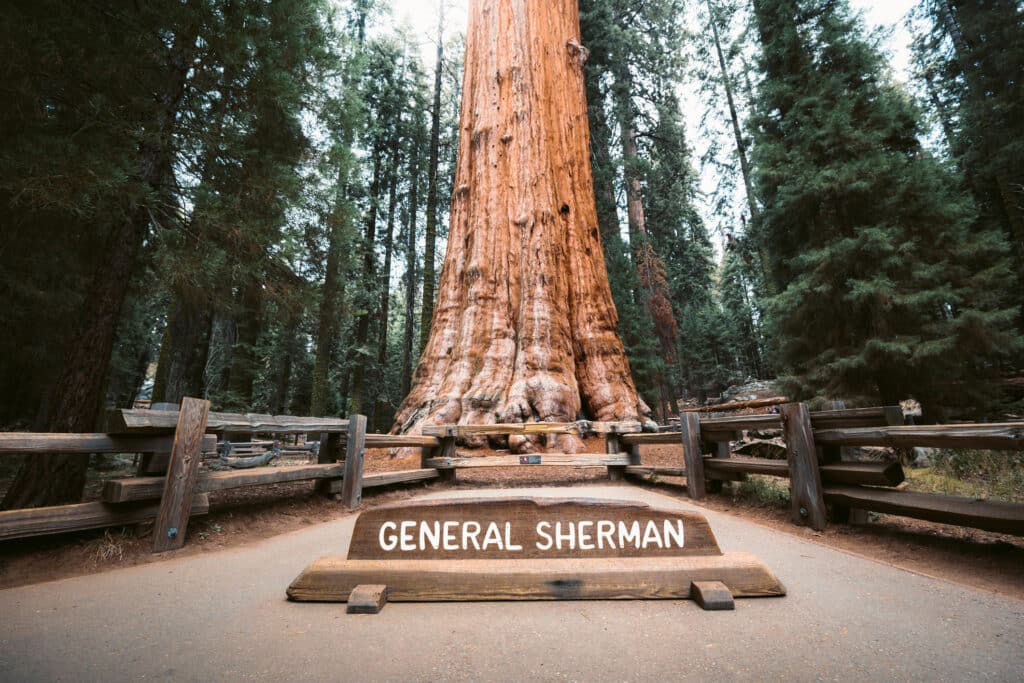
Sequoia National Park charges an entrance fee that covers both Sequoia and adjacent Kings Canyon National Parks. As of 2025, the standard entrance fee is $35 per private vehicle (valid for up to 7 days for all occupants of one car). Motorcyclists pay $30 per motorcycle (also good for 7 days). For individuals entering on foot or bicycle, the fee is $20 per person (ages 16 and up), while children 15 and under enter for free. If you’re planning multiple visits, an annual Sequoia & Kings Canyon park pass is available for $70. The America the Beautiful national parks pass is $80 and covers entry to all U.S. national parks; notably, U.S. seniors, active military members, veterans, visitors with permanent disabilities, and fourth-grade students’ families qualify for free or discounted versions of this national pass. (One important note: the park has gone cashless, so only credit/debit cards or digital payments are accepted at entrance stations.)
Sequoia National Park is open 24 hours a day, 365 days a year. There is no daily closing time for the park itself – the gates remain open even at night. However, certain park facilities and roads have seasonal schedules. During winter months, snowstorms can temporarily shut down some roads until they are cleared, and a few areas of the park close for the winter entirely (for example, the high-elevation Mineral King and Cedar Grove sections are accessible only from spring through fall). In summer, all park areas are generally accessible, though wildfire season may bring occasional restrictions (during periods of high fire danger, wood fires are banned and very rarely sections of the park could close if an active wildfire emerges). For most visitors, the key thing is that the main entrance roads and popular sites remain reachable year-round, with longer operating hours for visitor centers in summer. We visited on 11 August 2025, and all figures were valid then.
About the Sequoia National Park
Established in 1890, Sequoia National Park was the second national park created in the United States, set aside specifically to protect its namesake giant trees from logging. These giant sequoias are the park’s claim to fame – the largest trees on Earth by volume. Ever wondered how massive they really are? The park’s most famous resident, the General Sherman Tree, stands about 275 ft (84 m) tall with a trunk diameter of 36 ft (11 m) at the base. Many of these trees are over 2.000 years old (the General Sherman Tree is estimated around 2200 years). Walking among them, we felt tiny, as if we had traveled back in time standing beside living organisms that took root in the Roman era. The Giant Forest, named by naturalist John Muir in 1875, contains an estimated 8000 giant sequoia trees, each with its own huge girth and unique shape. It’s a humbling experience to follow the winding footpaths through this ancient woodland, surrounded by quiet colossi that have endured millennia of seasons.
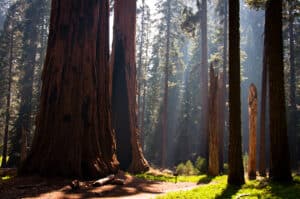
Sequoia National Park with giant trees
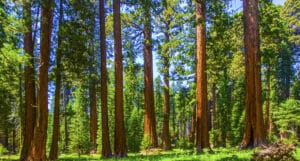
Sequoia trees in Sequoia National Park near Giant village area.
The park’s landscapes extend far beyond towering trees. Sequoia National Park spans elevation ranges from about 1.500 ft in the foothills to 14.500 ft at the alpine summit of Mount Whitney (the highest peak in the contiguous United States, located on the park’s eastern boundary). This dramatic range creates a rich mosaic of ecosystems. In the low foothill zone near the entrance, we hiked through warm, grassy hills and oak woodlands filled with spring wildflowers and birdlife. Dry chaparral slopes and groves of blue oak and incense cedar characterize these lower elevations – a completely different scene than the montane forests above. As we drove higher along the mountain road, the environment transformed before our eyes: we entered dense conifer forests of pine, fir, and eventually the giant sequoias around 5000–7000 ft.. Above the sequoia groves, the scenery transitions to alpine high country with sparkling granite peaks, wildflower meadows, and cold mountain streams. We found that in early summer some high trails were still patchy with snow, while the foothills below were already hot and dry – it’s like visiting multiple parks in one day.
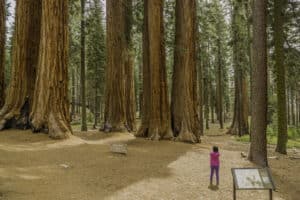
Giant Redwoods in Sequoia National Park being admired by visitors
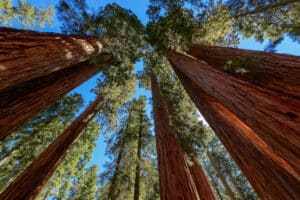
Giant sequoia trees in Sequoia National Park, California
The geology of Sequoia is just as impressive as its biology. The park sits in the mighty Sierra Nevada range, and its backbone is made of granite that has been uplifted and carved by glaciers. Many of the stunning cliffs and domes we saw – such as the granite dome of Moro Rock – are the result of this geologic history. In fact, we learned at the visitor center that this area was once beneath an ancient sea; over millions of years, tectonic forces and erosion sculpted the mountains we see today. One unique feature we explored is Crystal Cave, a marble cavern adorned with stalactites, hidden beneath the forest floor (guided tours of the cave operate in summer and require a separate small fee and advance reservation). From beneath the ground to the mountaintops, the park is full of natural wonders shaped by time.
Sequoia’s wildlife is diverse, though often shy. Black bears, mule deer, and coyotes roam the middle elevations – indeed, we spotted deer browsing in a meadow at dusk near our campground, utterly unbothered by our presence. (Following park guidelines, we always kept a safe distance and stored our food securely to avoid attracting bears.
Tip: We’d advise you to do the same – never leave snacks in your car, since the clever bears here have been known to break into vehicles if they smell food!). Smaller creatures like squirrels and chipmunks are common around picnic areas, while the high rocky ridges harbor yellow-bellied marmots and pikas. Birdlife ranges from colorful Steller’s jays in the forests to majestic raptors soaring above the canyon. If you’re lucky (and patient), you might catch sight of a California condor overhead or a mountain lion slipping through the woods, but those are very rare. The park is also home to some endangered species, like the tiny mountain yellow-legged frog that lives in alpine streams. Park biologists have been working to protect these vulnerable creatures – for example, by restoring natural habitats and even reintroducing the Sierra Nevada bighorn sheep to parts of the high country.
From a conservation standpoint, Sequoia has a fascinating and ongoing story. Park was originally created to guard the giant sequoias, and that mission continues with modern challenges. The giant sequoia species (Sequoiadendron giganteum) itself is now classified as Endangered on the IUCN Red List, partly due to its very limited natural range and emerging threats like climate change and intense wildfires. In recent years, wildfires have become a major concern – events like the 2021 KNP Complex Fire impacted several sequoia groves. In response, the park has strengthened its fire management policies. Rangers conduct controlled burns (prescribed fires) under safe conditions to clear underbrush, reduce fuel buildup, and mimic the natural fire cycle that these groves depend on. We saw evidence of past prescribed burns in the Giant Forest: patches of charred bark on some sequoias, which actually help the trees by opening their cones and creating fertile ash soil for seedlings. In addition, special efforts were made to protect iconic trees during extreme fires (for instance, we heard that firefighters had wrapped the base of General Sherman Tree in fire-resistant material during a big fire threat). Beyond fire, the park engages in ecological restoration projects – one example we learned about is a meadow restoration where an eroded alpine wetland was rehabilitated back into a healthy marsh habitat, allowing native plants and animals to thrive again.
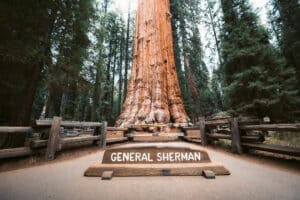
General Sherman Tree, the world`s largest tree by volume, Sequoia National Park, California, USA.
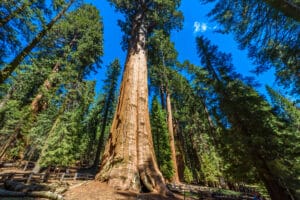
General Sherman Tree – the largest tree on Earth, Giant Sequoia Trees in Sequoia National Park, California, USA
Sequoia National Park’s significance is recognized globally as well. In 1976 the park (together with Kings Canyon) was designated as a UNESCO Biosphere Reserve, underscoring the worldwide importance of preserving its ecosystems. Generations of nature lovers, scientists, and park rangers have studied and safeguarded these forests. Legendary conservationist John Muir himself explored here in the 1870s, and his writings helped raise awareness about the Sierra Nevada’s wonders. We’ve seen that legacy continue through modern research and partnerships – for instance, organizations like the National Geographic Society and Save the Redwoods League have ongoing projects in the area, from mapping the tallest sequoias to examining how to best protect them for the future. All of this work ensures that when you visit today, you can not only enjoy an awe-inspiring hike among ancient giants, but also understand the crucial efforts underway to keep this place wild and magnificent for the next generation.
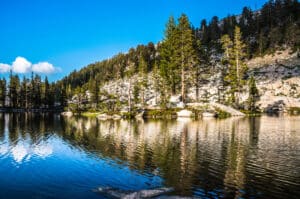
Mosquito Lakes, Sequoia National Park, California, USA
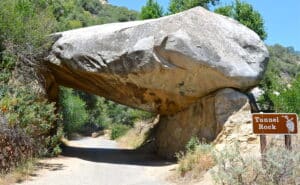
Tunnel Rock, Sequoia National Park, California,USA
What about the practical side of exploring Sequoia? Most visitors spend at least one full day in the park, but we recommend a bit more time if you can. In our experience, two days allowed us to see the major sights without rushing, and three days would be ideal to venture on some longer hikes or to also tour neighboring Kings Canyon National Park. It’s kinda tempting to try to “do Sequoia in a day,” and you can certainly get a taste of the big trees in a few hours, but you’ll miss out on so much by speeding through. The park’s highlights are relatively close together (for example, the main Giant Forest attractions are linked by short trails and shuttle buses in summer), so you don’t necessarily have to undertake epic treks to see the famous spots. Are we gonna have to hike for hours to see those giant trees? Not at all! Even a short 0.5 mile stroll from a parking area can bring you face-to-trunk with giants like the Sentinel or the General Sherman Tree. That said, if you love hiking, there are plenty of trails ranging from easy nature walks to strenuous mountain adventures. We’ve found that early mornings are wonderfully quiet among the groves – a perfect time for wildlife sightings and photographs with soft light – whereas midday brings more crowds to the popular sites. To dodge the tour bus groups, we often plan to visit the most popular stops either early or late in the day, and explore some less-known trails during peak hours.
Nearby Sights and Food Options:
After immersing ourselves in Sequoia’s main attractions, we also took time to enjoy the surrounding experiences. Here are some of the highlights both inside the park and just outside its borders that we loved:
Sights & Trails Inside the Park:
-
General Sherman Tree & Congress Trail: We made sure our first stop was at the General Sherman Tree, which is conveniently accessed via a short paved path from the parking area. Alongside dozens of other amazed visitors, we stood at the base of this gargantuan tree, craning our necks to see the top. After snapping the obligatory photo with Sherman, we continued on the Congress Trail, a 2.7 mile (4.3 km) loop that winds through the heart of the Giant Forest. On this loop, we passed clusters of other named giant sequoias like the Senate and House groupings and the President Tree. The trail was mostly gentle; it felt peaceful as soon as we left the crowds behind near Sherman. (Trail tip: Go in the morning for cooler temperatures and fewer people. We had a serene walk with only a few other hikers on the path.)
-
Moro Rock: This granite dome offers one of the most spectacular viewpoints in the park. We climbed the 350 steps carved into Moro Rock’s flank one afternoon. It was a short but steep ascent, and at 6,725 ft (2,050 m) elevation, we definitely felt our hearts pumping by the time we reached the top. The reward was a 360-degree panorama of the Great Western Divide mountain peaks and deep valleys below. We had clear skies, so we could see for dozens of miles – an unforgettable vista that really put the park’s vastness in perspective. Standing up there, with a light breeze and eagles soaring at eye level, was absolutely worth the climb.
-
Tunnel Log & Crescent Meadow: Driving along the narrow road to Crescent Meadow, we encountered the famous Tunnel Log – a giant sequoia tree that fell across the road in 1937 and was then hollowed out so that cars could drive through. Of course, we had to try it – we slowly drove our car through the carved tunnel in the trunk, and yes, it’s a fun little photo-op moment. Beyond the log, at road’s end, we took a leisurely stroll around Crescent Meadow, a lovely green clearing surrounded by sequoias that John Muir dubbed the “Gem of the Sierra”. In the past, black bears have been frequently seen here grazing on fruits in late summer, though we didn’t see any during our walk. We did spot the historic Tharp’s Log cabin (an early settler’s tiny cabin made from a fallen sequoia log) by the meadow’s edge, which made us imagine what pioneer life might have been like among these giants.
-
Tokopah Falls: This was our favorite half-day hike. The trailhead starts near Lodgepole Campground, and the hike is about 1.7 miles (2.7 km) one-way following the Marble Fork of the Kaweah River up a picturesque canyon. The path was moderate – a gradual uphill with some rocky sections, but nothing too difficult. We hiked in the late afternoon and had the trail mostly to ourselves. At trail’s end, Tokopah Falls cascades down a granite cliff in a series of horsetails and plunges, dropping a total of 1,200 ft (366 m) in multiple tiers. Since we visited in early summer, the waterfall was thunderous with snowmelt, sending up a cooling mist. We sat on a boulder at the base of the falls, enjoyed a picnic snack, and watched a rainbow form in the waterfall’s spray. This hike offered a gorgeous change of scene – from big trees to alpine granite landscapes – all within a couple of hours.
-
High Sierra Trails: For those with more time or seeking backcountry adventure, Sequoia is a launching point for longer treks. We only dabbled in a section of the famous High Sierra Trail, which actually runs ~60 miles across the Sierra to Mount Whitney. Even a short day-hike along its early miles was rewarding, with pristine mountain views and wildflowers. Ambitious hikers with permits tackle Mount Whitney itself (typically via an approach from the eastern side at Whitney Portal, but you can also reach it from Sequoia’s backcountry). We didn’t attempt Whitney on this trip, but just knowing the highest continental U.S. peak stood at the far end of the park made our time here feel even more epic.
Dining & Nearby Stops in Three Rivers:
-
Sierra Subs & Salads (Three Rivers): After a long day of hiking under the giant trees, we drove out the Ash Mountain entrance to find a hearty meal in the nearest town, Three Rivers. Based on rave reviews from fellow travelers, we stopped at Sierra Subs & Salads for lunch. This small local deli had a charming, casual vibe and a menu of gourmet sandwiches, fresh salads, and cold drinks – just what we needed. We ordered a turkey-avocado sandwich and a big salad to share, and enjoyed them at an outdoor picnic table with a view of the Kaweah River. Everything was made-to-order with fresh ingredients (the bread was especially soft and fresh). It was the perfect refueling stop, and we understood why this place is beloved by visitors and locals alike.
-
The Gateway Restaurant & Lodge: One evening, we treated ourselves to dinner at The Gateway, a historic lodge and restaurant located right by the park boundary (about a half mile from the Sequoia park entrance). The restaurant’s deck sits overlooking the rushing Kaweah River – we got a table outside right above the water and even felt a slight cool mist from the river below. The setting was unbeatable as dusk settled over the surrounding hills. The menu offered classic American fare; we indulged in a grilled steak (sourced from a well-known local beef ranch) and rainbow trout almondine, paired with a California red wine. After days of camp cooking, having a proper sit-down dinner with linen napkins felt like luxury. The food was delicious (especially the steak, perfectly cooked and tender) and the atmosphere was relaxed and friendly. By the end of the meal we were pleasantly full and lingered a bit just to soak in the night sky emerging over the mountains.
-
Reimer’s Candies and Ice Cream: No trip to Three Rivers is complete without a stop at Reimer’s, an old-fashioned candy store and ice cream shop on the main road. We wandered in after dinner and felt like a step back in time. The shop’s glass cases were filled with handmade chocolates, truffles, and vintage candies – it was nostalgic and charming. Ultimately, we couldn’t resist getting a couple of scoops of ice cream (their signature Swiss Orange Chocolate Chip flavor was fantastic – rich chocolate with a hint of citrus). We sat on a bench outside the shop, enjoying our dessert under the stars. It was a sweet way to end the day, literally!
-
Totem Market & Gifts: On our way out of town, we stopped by Totem Market, a combination roadside barbecue joint, mini-market, and gift shop. This quirky spot had a giant totem pole sign and a friendly owner who chatted with us. We picked up a few souvenirs here – a locally made ornament featuring a tiny carved bear (to remind us of the real ones in Sequoia) and a couple of postcards. They also sell barbecue and sandwiches; the smoked tri-tip on their grill looked amazing – it tempted us even though we’d just eaten breakfast. In the end, we grabbed coffees to-go and some freshly baked muffins from their counter for the road. Totem Market was a convenient last stop to fuel up (both the car and ourselves) before we headed off on the next leg of our journey.
After experiencing Sequoia National Park in depth, we came away with a deep appreciation for this place. From walking among ancient giants to gazing across mountain panoramas and then relaxing by a riverside café, every part of the visit felt enriching. Each section of the park offered something different: giant trees that made us feel like ants, trails that led us to hidden waterfalls, and night skies full of stars above quiet campfires. Our personal advice? We definitely recommend giving yourself enough time to slow down and savor it. This isn’t the kind of park you rush through; its one to take in slowly, with all your senses. At Sequoia, you can really sense the passage of time – in the growth rings of a fallen sequoia, in the stories of early explorers, and in the conservation work being done to protect it for the future. In the end, we left feeling inspired and recharged. We’re already dreaming of our next visit, when we’ll wander those forest paths again and maybe discover even more secrets under the canopy of giants.
Sorry, there were no items that matched your criteria.

